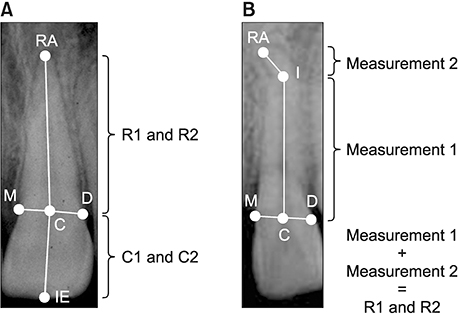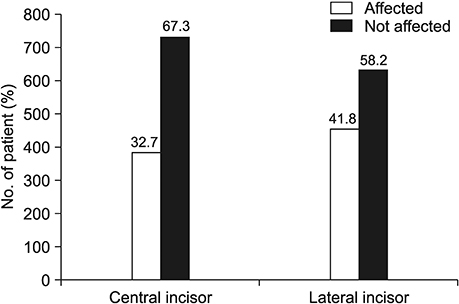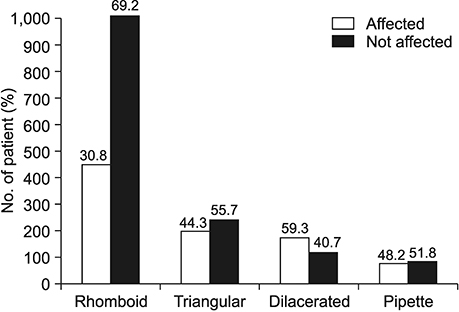Korean J Orthod.
2019 Sep;49(5):310-318. 10.4041/kjod.2019.49.5.310.
Predisposing factors for external apical root resorption associated with orthodontic treatment
- Affiliations
-
- 1Department of Orthodontics, School of Dentistry, State University of Rio de Janeiro, Rio de Janeiro, Brazil. jonascapelli@gmail.com
- 2Department Of Orthodontics, School Of Dentistry, Pontifical Catholic University Of Minas Gerais, Belo Horizonte, Brazil.
- 3Department of Cell Biology, Institute of Biological Science, Federal University of Minas Gerais, Belo Horizonte, Brazil.
- 4Department of Orthodontics, School of Dentistry, Federal University of Minas Gerais, Belo Horizonte, Brazil.
- KMID: 2458619
- DOI: http://doi.org/10.4041/kjod.2019.49.5.310
Abstract
OBJECTIVE
This study aimed to identify possible risk factors for external apical root resorption (EARR) in the maxillary incisors after orthodontic treatment.
METHODS
The root length of 2,173 maxillary incisors was measured on periapical radiographs of 564 patients who received orthodontic treatment. The Kappa test was performed to evaluate intraexaminer and interexaminer reproducibility. Multiple binary logistic regression was used to determine the association between EARR and various factors. Odds ratios and 95% confidence intervals were reported.
RESULTS
The risk of developing EARR was 70% higher in orthodontic treatment with maxillary premolar extraction (p = 0.004), 58% higher in patients with increased overjet (p = 0.012), 41% lower in two-phase orthodontic treatment (p = 0.037), and 33% lower in patients with deep bite (p = 0.039). The lateral incisors were 54% more likely to develop EARR (p < 0.001), dilacerated roots were 2.26 times more likely to develop EARR (p < 0.001), and for each additional millimeter of root length, the risk of EARR increased by 29% (p < 0.001).
CONCLUSIONS
The potential risk factors for EARR after orthodontic treatment included treatment with maxillary premolar extraction, increased overjet at the beginning of treatment, and dilacerated roots.
Keyword
MeSH Terms
Figure
Reference
-
1. Brezniak N, Wasserstein A. Orthodontically induced inflammatory root resorption. Part II: the clinical aspects. Angle Orthod. 2002; 72:180–184.2. Hartsfield JK Jr, Everett ET, Al-Qawasmi RA. Genetic factors in external apical root resorption and orthodontic treatment. Crit Rev Oral Biol Med. 2004; 15:115–122.
Article3. Brezniak N, Wasserstein A. Orthodontically induced inflammatory root resorption. Part I: the basic science aspects. Angle Orthod. 2002; 72:175–179.4. Weltman B, Vig KW, Fields HW, Shanker S, Kaizar EE. Root resorption associated with orthodontic tooth movement: a systematic review. Am J Orthod Dentofacial Orthop. 2010; 137:462–476. discussion 12A.
Article5. Brezniak N, Wasserstein A. Root resorption after orthodontic treatment: part 2. Literature review. Am J Orthod Dentofacial Orthop. 1993; 103:138–146.
Article6. Roscoe MG, Meira JB, Cattaneo PM. Association of orthodontic force system and root resorption: a systematic review. Am J Orthod Dentofacial Orthop. 2015; 147:610–626.
Article7. Segal GR, Schiffman PH, Tuncay OC. Meta analysis of the treatment-related factors of external apical root resorption. Orthod Craniofac Res. 2004; 7:71–78.
Article8. Sameshima GT, Sinclair PM. Predicting and preventing root resorption: part I. Diagnostic factors. Am J Orthod Dentofacial Orthop. 2001; 119:505–510.
Article9. de Freitas JC, Lyra OC, de Alencar AH, Estrela C. Long-term evaluation of apical root resorption after orthodontic treatment using periapical radiography and cone beam computed tomography. Dental Press J Orthod. 2013; 18:104–112.
Article10. Maués CP, do Nascimento RR, Vilella Ode V. Severe root resorption resulting from orthodontic treatment: prevalence and risk factors. Dental Press J Orthod. 2015; 20:52–58.
Article11. Levander E, Malmgren O, Stenback K. Apical root resorption during orthodontic treatment of patients with multiple aplasia: a study of maxillary incisors. Eur J Orthod. 1998; 20:427–434.
Article12. Picanço GV, de Freitas KM, Cançado RH, Valarelli FP, Picanço PR, Feijão CP. Predisposing factors to severe external root resorption associated to orthodontic treatment. Dental Press J Orthod. 2013; 18:110–120.
Article13. Fontana ML, de Souza CM, Bernardino JF, Hoette F, Hoette ML, Thum L, et al. Association analysis of clinical aspects and vitamin D receptor gene polymorphism with external apical root resorption in orthodontic patients. Am J Orthod Dentofacial Orthop. 2012; 142:339–347.
Article14. Lee YJ, Lee TY. External root resorption during orthodontic treatment in root-filled teeth and contralateral teeth with vital pulp: a clinical study of contributing factors. Am J Orthod Dentofacial Orthop. 2016; 149:84–91.
Article15. Sharab LY, Morford LA, Dempsey J, Falcão-Alencar G, Mason A, Jacobson E, et al. Genetic and treatmentrelated risk factors associated with external apical root resorption (EARR) concurrent with orthodontia. Orthod Craniofac Res. 2015; 18 Suppl 1:71–82.
Article16. Brin I, Tulloch JF, Koroluk L, Philips C. External apical root resorption in Class II malocclusion: a retrospective review of 1- versus 2-phase treatment. Am J Orthod Dentofacial Orthop. 2003; 124:151–156.
Article17. Mehta SA, Deshmukh SV, Sable RB, Patil AS. Comparison of 4 and 6 weeks of rest period for repair of root resorption. Prog Orthod. 2017; 18:18.
Article18. Linge L, Linge BO. Patient characteristics and treatment variables associated with apical root resorption during orthodontic treatment. Am J Orthod Dentofacial Orthop. 1991; 99:35–43.
Article19. Aras I, Tuncer AV. Comparison of anterior and posterior mini-implant-assisted maxillary incisor intrusion: root resorption and treatment efficiency. Angle Orthod. 2016; 86:746–752.
Article20. Linge BO, Linge L. Apical root resorption in upper anterior teeth. Eur J Orthod. 1983; 5:173–183.
Article21. Landis JR, Koch GG. The measurement of observer agreement for categorical data. Biometrics. 1977; 33:159–174.
Article22. Sameshima GT, Asgarifar KO. Assessment of root resorption and root shape: periapical vs panoramic films. Angle Orthod. 2001; 71:185–189.23. Brezniak N, Goren S, Zoizner R, Dinbar A, Arad A, Wasserstein A, et al. A comparison of three methods to accurately measure root length. Angle Orthod. 2004; 74:786–791.24. Bastos Lages EM, Drummond AF, Pretti H, Costa FO, Lages EJ, Gontijo AI, et al. Association of functional gene polymorphism IL-1beta in patients with external apical root resorption. Am J Orthod Dentofacial Orthop. 2009; 136:542–546.
Article25. Artun J, Van 't Hullenaar R, Doppel D, Kuijpers-Jagtman AM. Identification of orthodontic patients at risk of severe apical root resorption. Am J Orthod Dentofacial Orthop. 2009; 135:448–455.
Article26. Jiang F, Chen J, Kula K, Gu H, Du Y, Eckert G. Root resorptions associated with canine retraction treatment. Am J Orthod Dentofacial Orthop. 2017; 152:348–354.
Article27. Currell SD, Liaw A, Blackmore Grant PD, Esterman A, Nimmo A. Orthodontic mechanotherapies and their influence on external root resorption: a systematic review. Am J Orthod Dentofacial Orthop. 2019; 155:313–329.
Article28. Aminoshariae A, Aminoshariae A, Valiathan M, Kulild JC. Association of genetic polymorphism and external apical root resorption. Angle Orthod. 2016; 86:1042–1049.
Article29. Nowrin SA, Jaafar S, Ab Rahman N, Basri R, Alam MK, Shahid F. Association between genetic polymorphisms and external apical root resorption: a systematic review and meta-analysis. Korean J Orthod. 2018; 48:395–404.
Article
- Full Text Links
- Actions
-
Cited
- CITED
-
- Close
- Share
- Similar articles
-
- A study on the affecting factors on root resorption
- Comparison between anterior segmental osteotomy versus conventional orthodontic treatment in root resorption: a radiographic study using cone-beam computed tomography
- External apical root resorption in maxillary incisors in orthodontic patients: associated factors and radiographic evaluation
- External root resorption after orthodontic treatment: a study of contributing factors
- The changes of root length and form in immature teeth after orthodontic treatment





